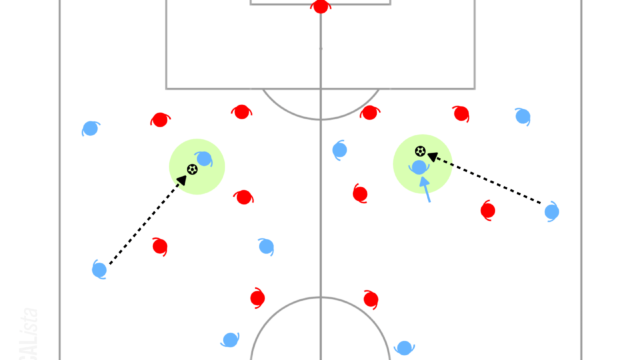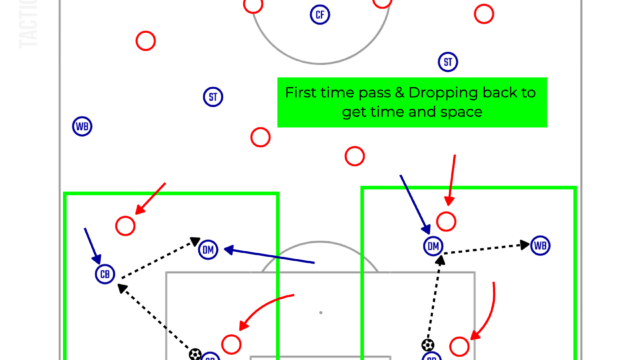Introduction
One of the most important ideas to understand modern football is ‘Positional Play’. This idea was said to be generalised and verbalised when Pep Guardiola arrived at Germany to coach players who had no idea about it. When Pep managed Barcelona, the most players were familiar with positional play thanks to the academy system and culture in Barcelona. However, when he came to Bayern München, in order to install the idea of positional play, he was forced to generalise it to make it clear for everyone. This was not for the players of Bayern München, but for us as well. Thanks to his generalisation, it became possible for all football coaches or fans to understand the idea of positional play. And the purpose of this article is discussing the basic idea of positional play, the evolution of opposition ideas against positional play and the fashion of modern football right now.
On the internet or through books, it is possible to access many explanations or analysis of positional play, and of course this article is one of them, but it makes confusion for us to understand the idea due to the differences of choice of words or definitions. Some refer the quotes from managers, but they use different words, which makes it complicated. However, one of the most reliable sources can be Pep’s words and professional analyst’s discussion. The books below are highly recommendable to know practical and concrete application of positional play.
Pep Confidential
This book is the story of Pep’s first season at Bayern München, which deeply discussed and explained how he tried to install positional play in the German club. There are so many conversations between the author and Pep or players and it is extremely insightful. One of the most interesting things in this book is how he planned for each game. There are so many discussions to select tactics, players and plans. After reading this book, you will understand the basic idea of positional play and practical application at the elite level.
Pep Guardiola: The Evolution
This book is the second part of Pep Confidential. If you like the first one, you need this one. As the title suggests, how he progressed Bayern and what he was looking for Man City are the main topic of this book.
Record Breakers
The previous books were about positional play before 2016. However, after he came to England and reached 100 points in 2017-18 with Man City, another manager also conquered England and Europe. He is Jürgen Klopp. Liverpool also completed his style of football with positional play to become more stable and dangerous in possession. Both historic teams were analysed by a former Crystal Palace analyst, Rob Weaver and his point of view is extremely interesting. His knowledge as a professional analyst is so deep and he explained positional play in both abstract and concrete ways. After reading this book, you will understand the modern football more deeply.
What is Positional Play?
In this article, the basic idea of positional play is going to be explained. This explanation might cause some critics though, it is possible to say that positional play is all about the logic of the numerical advantage and positional advantage, not the quality of players. I understand your thoughts such as ‘football is about players’ or ‘the quality of players is the most important’. Yes, I understand them. However, to understand positional play, we need to start the conversation from accepting that statement.
What we need to understand is positional play is an idea or philosophy, not a tactic. If it comes to tactics for a plan for each game or building a team, there is so much room to consider about the quality of players. However, in the level of ideas or philosophy, it is noise. All numerical and positional advantages and how to utilise them must be perfect on the board. Whether it can be performed perfectly on the pitch depends on the level and quality of players.
This always leads arguments such as ‘it prevents the creativity of players’ or ‘players are not robots’. Imagine when playing out from the back. Is the creativity of players important? Do you want your centre back to take on the opposition striker and play a 1v1? In these situations, what really matters is how safely progress the ball towards the opposition goal. And then, when the creativity matters is in the opposition final third. In football, there are two games, how to progress the ball and how to score a goal.

Positional play gives players a skill to play without a skill. Numerical and positional advantages help players to break the opposition lines without a skill. It is basically a skill without a ball. On the other hand, if there are no numerical and positional advantages, players need to solve the situation basically with a skill on the ball. They cannot live together.
Numerical Advantage & Positional Advantage
In this chapter, both numerical and positional advantages are going to be explained. Firstly, the numerical advantage is going to be discussed.
On the pitch, without any red cards or injuries, there are 11 players for each team. There are no numerical advantages. However, it is possible to create a numerical advantage in a certain area of the pitch. One of the obvious reasons is the presence of a goalkeeper in possession to make it 11v10 against the defending team. The reason of this and the effectiveness was deeply analysed in the article below, so please have a look at it.

In this chapter, the focus is on how to create numerical advantages in 10v10 without the goalkeeper. The crucial reason is the matchup of systems. In the context of zonal defending, which has been a trend for a couple of decades, the defending players position themselves based on their system, not the opposition players. In this circumstance, the attacking team could gain numerical advantages by positioning more players in a certain area. However, this would result in losing a numerical advantage in other area. To overcome this problem, in positional play, there are three key factors, pinning the opponents, positioning in between the lines and progressing the advantage.
Pinning the opponents means preventing more opponents from leaving their positions by fewer players. For example, deploying three attackers up front to fixate the opposition back four has been one of the most common formulas. This provides a numerical advantage for the rest of the pitch.

The key of pinning the opponents is showing the threat behind them and positioning in between two opponents. If an attacker always seeks to run in behind, it is difficult for the marker to leave the movement. Additionally, by being between two opponents, they cannot leave their positions which may risk being exploited the gap.
Another key factor is positioning in between the lines. Mostly, in the context of zonal defending, the defending team has three lines because it is thought to be the most balanced. If there are only two lines, it becomes easier for the opposition to play over and if there are four lines, it becomes easier for the opposition to play around. This is the hidden logic. On the other hand, the attacking team can have four lines such as 2-3-2-3, 3-2-2-3 or 3-1-3-3. This makes players in the middle to influence on the opposition two lines, which can create a numerical advantage.

The pivot can influence on the opposition strikers and create an overload at the back even though the number of centre backs and opposition strikers is equal. Additionally, the pivot can also have an impact on the opposition midfield line after the ball is played through the opposition first line. Like this, the attacking midfielders can provide overloads against both the opposition midfield line and back line.
The third one is progressing an advantage. The difference between the second one and this is that in the second pattern, they create numerical advantages against all opposition lines by the positions, but in this one, the numerical advantages are created by a movement.

When there is already a numerical advantage against the opposition line with a line, it is highly important to carry the ball forwards to attack the next opposition line. This is how to progress the advantage. Without this, due to the numerical advantage in a certain area, at the back in this example, they need to accept the numerical disadvantages in the rest of the pitch. Therefore, to gain numerical advantages all over the pitch, the advantage at the back needs to be carries to the next phase.
In this chapter, how to create numerical advantages with positional advantages was discussed. Both advantages are highly related and positional advantages can provide numerical advantages in the game where there are usually no numerical advantages.
Pitch Geography & Opposition Positions
In this chapter, the difference between positioning based on the pitch geography and the opposition positions is going to be discussed.
Five lanes, which Pep has drawn on the pitch are the example of positioning based on the pitch geography. The five attackers up front position themselves to occupy each lane to keep connecting each other to play some combinations.

On the other hand, when positioning themselves based on the opposition positions, their reference points alter. The difference appears when the ball is in a wide area and the opposition players shuffle across the pitch.

Based on the five lanes, even though the opposition players shift across, the positions of the attackers do not change. However, based on the opposition positions, it changes.

This difference hugely influences on the playing style. To attract the opposition in the ball side and exploit the opposite side by quickly switching the ball, the shape based on the five lanes is suitable because thanks to the balanced shape, they can have numerical and positional advantages in the opposite side against the narrow opposition shape. On the other hand, when positioning themselves based on the opposition shape, they can still manage to have numerical and positional advantages in the ball side, so they can try to break the opposition lines vertically even though the space is tighter.
In terms of the weaknesses, if deploying attackers in each lane and playing with a balanced shape, as long as the opposition team can shuffle over perfectly, it is difficult to create advantages in the opposite side. On the other hand, positioning attackers based on the opposition positions can constantly create numerical and positional advantages in the ball side, but the space is too tight to play through and it requires the quality of players on the ball. In other words, they are locked in the compact area.
Both ideas are based on how to interpret positional play, but it will be different style of play.
Static & Dynamic Structure
A few years ago, positional play was static. Man City played with the 3-2-5 or 2-3-5 and they created so many chances with some regular patterns. However, right now, it is almost impossible to play well with a static system.
One of the common solutions against positional play is defending with a back five. It nullifies the numerical and positional advantages of the five attackers. It is still possible to play with six attackers against five defenders, but the available space for the attacking team is tighter than 5v4, it becomes harder to play against the back five.
Not only just reducing the available space but also marking the attackers tightly is the strength of the back five. Since one of the main objectives of positional play is avoiding duels by numerical and positional advantages, marking the players tightly is a good solution against positional play.
To overcome this defensive solution, teams of positional play need to be dynamic to lose the opposition markers, in other words, rotations.

Even though marking players tightly, it is almost impossible to keep marking players all over the pitch. Especially, as the illustration above shows, when the fullback makes a run in behind, the opposition fullback will be in doubt and forced to make a decision if keeping marking the winger or swapping each marker with a teammate. If the triangle rotates, it is difficult for the defenders to deal with it.
How to beat man marking is not the main topic of this article though, the key is keeping the shape after rotations. If players move anywhere they want to go, the shape will be messed up. However, for positional play, the most important thing is keeping the shape even after rotations. As the illustration above shows, grouping the players is a good method. They are connected, so the shape is balanced even after rotations. This dynamic structure is the recent evolution of positional play.
The Quality of Players
The discussion of numerical and positional advantages has been done. And due to the recent rise of man marking, the structure needs to be more dynamic. Now, certain quality of players is required.
Following the discussion above, under tight pressure, individual skill of keeping the ball becomes more and more essential. Yes, Man City signed Jack Grealish, this is the answer made by the professor. He can receive the ball with the opposition pressure from his back, dribble inside to attract the opposition players and switch it to the opposite side. This skill on the ball is particularly important when building up against tight marking.
Needless to say, in the final third, where the space is tight and congested, individual quality makes a difference. In this phase, positional play is not enough anymore. Players who developed with mainly the logic of positional play are good at avoiding duels, but not winning duels. This is the problem which Spain or Germany has faced.
Positional play is one of the ideas in football, not the perfect way to win a game. It is wrong to blindly believe in it, but it is also wrong to reject it. Positional play is still influencing many teams in different ways and it keeps evolving.
Thank you for reading. I hope you enjoyed it.




